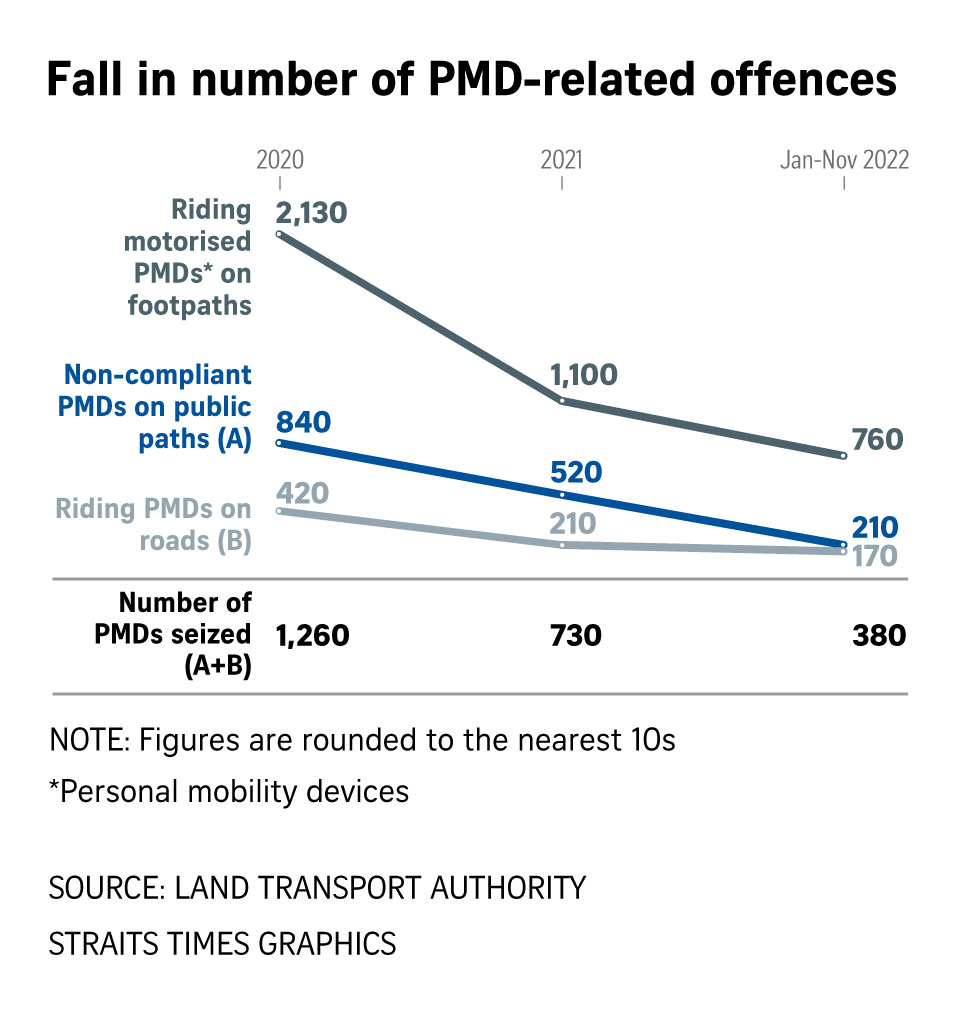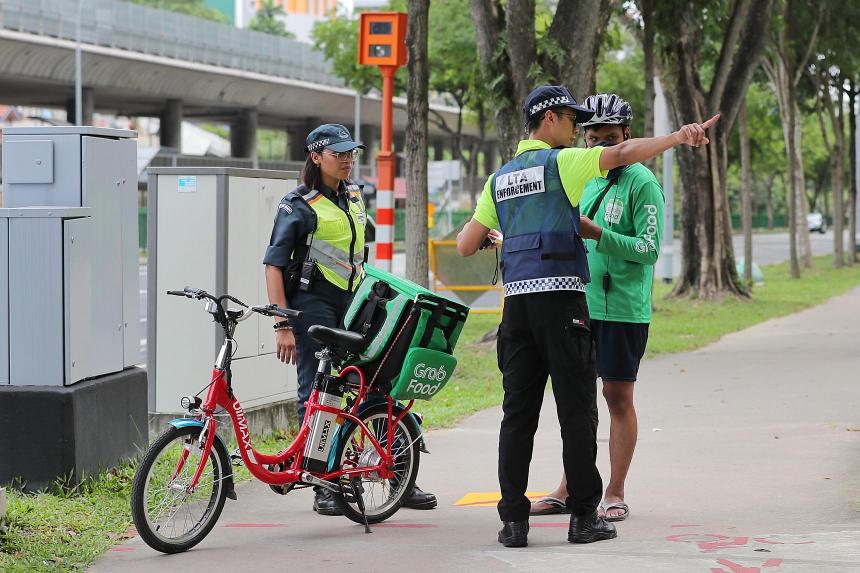SINGAPORE – The number of offences involving personal mobility devices (PMDs), which include e-scooters, has fallen by more than 65 per cent from 2020 to 2022 as the e-scooter population continues to decrease after it was banned from footpaths in November 2019.
There were 1,140 offences recorded between January and November 2022, down from 3,390 in 2020, based on figures given by Transport Minister S. Iswaran in a written parliamentary reply to Workers’ Party (WP) MP Dennis Tan in January.
These offences comprise riding PMDs on footpaths and roads, as well as using non-compliant PMDs on public paths.
This decline comes as the number of registered e-scooters fell to 5,192 as at end-December 2022, from 8,500 in March 2021.
In their heyday in 2019, there were about 100,000 registered e-scooters. But a spate of accidents and growing concerns about safety prompted the Government to ban e-scooters on footpaths, curtailing their use and leading to a sharp decline in the e-scooter population.
The number of PMD users nabbed for riding on footpaths fell from 2,130 in 2020 to 760 in the first 11 months of 2022.
In the same period, the number of users caught for riding PMDs on roads fell from 420 to 170. PMDs are allowed only on cycling paths and park connector networks.
WP’s Mr Tan said: “It is good to see the decline in figures with the increased enforcement and public education but, that said, there is still a large number of offences reported for PMDs riding on footpaths and roads, so I hope the authorities will continue to enhance their various efforts in the coming year.”
Meanwhile, the number of offences for using non-compliant PMDs on public paths dropped by 75 per cent from 840 in 2020 to 210 in the first 11 months of 2022.
Currently, only PMDs certified under the UL2272 safety standard are allowed. Non-compliant PMDs comprise those that have been illegally modified or do not meet the Land Transport Authority’s requirements, such as weight and speed limits.
In a written parliamentary reply to Ang Mo Kio GRC MP Gan Thiam Poh, Mr Iswaran said the total number of fires involving non-compliant PMDs – including those illegally modified – fell from 42 in 2020 to 12 between January and October 2022.
Replying separately to Radin Mas MP Melvin Yong, he said 295 riders were caught riding registered PMDs that did not meet requirements between January 2020 and November 2022, while 70 violations involving such PMDs were detected from operations against retailers.

Since April 2020, e-scooters have had to undergo inspection every two years to ensure they comply with regulations. Those found non-compliant will be deregistered and cannot be used on public paths.
Mr Iswaran said about 4 per cent of e-scooters undergoing periodic inspection have failed the inspection and were deregistered since May 2022.
Mr Yong told The Straits Times that he had asked about enforcement against PMDs that are modified after registration as he was concerned about the safety of these illegally modified devices.
“Many PMD users use their devices responsibly, but there remains a few errant users and retailers who illegally modify PMDs,” he said. “This poses a danger to the users and others around them, as the illegal modifications can become fire hazards.”
Mr Denis Koh, chairman of PMD enthusiast group Big Wheel Scooters Singapore, said: “There are some black sheep who are still illegally modifying their e-scooters or riding on footpaths and roads, but it is not as widespread as there are a lot of eyes watching them.”
At the height of the e-scooter’s popularity between July and November 2019, retailer Mobot could sell more than a thousand of the devices each month.
Now, Mobot’s e-scooter sales are just 1 per cent to 2 per cent of what they were previously, with about 10 to 20 of them sold each month.
“The market demand is just not there any more,” said Mobot managing director Ifrey Lai. “Currently, those who are still using PMDs are people who live near park connector networks and cycling paths.”
While Mr Koh said many riders who used to ride e-scooters have switched to power-assisted bicycles, he foresees e-scooters making a comeback in the future as more cycling paths are built.
The cycling path network is slated to grow from 530km now to 1,300km by 2030.
“The connectivity between cycling paths is a lot better today compared with three years ago,” said Mr Koh, citing the Round Island Route as an example.
The continuous 150km park connector, when completed by 2035, will be the longest recreational connection looping around the island. The first phase of the route, which stretches 75km, was launched in January 2022.
“The use of PMDs helps to take cars off the road and build a car-lite society, which is what Singapore is working towards,” said Mr Koh. “With the bigger push for electric vehicles in the future, I believe PMDs might become popular again with more connecting cycling paths.”


